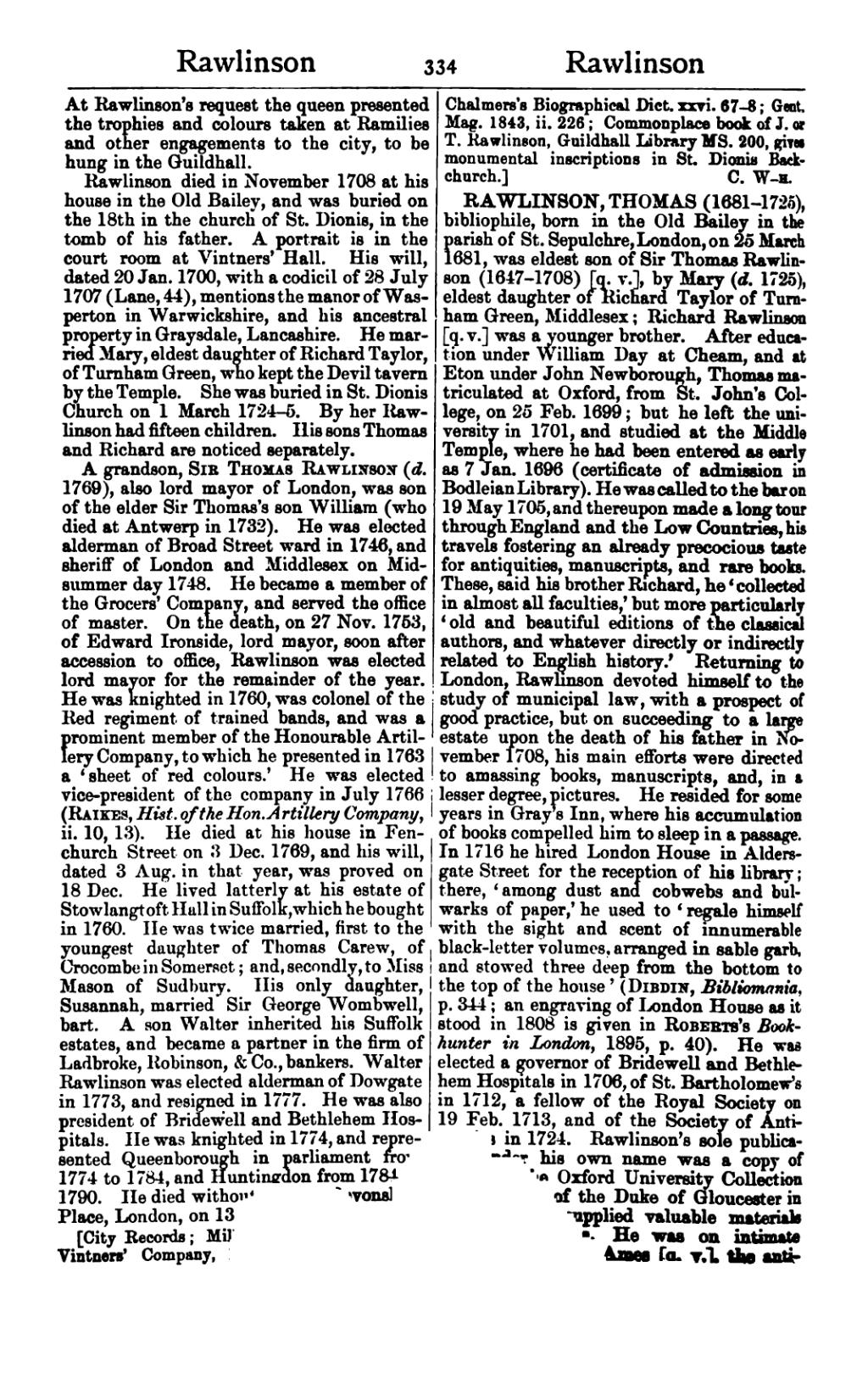At Rawlinson's request the queen presented the trophies and colours taken at Ramilies and other engagements to the city, to be hung in the Guildhall.
Rawlinson died in November 1708 at his house in the Old Bailey, and was buried on the 18th in the church of St. Dionis, in the tomb of his father. A portrait is in the court room at Vintners' Hall. His will, dated 20 Jan. 1700, with a codicil of 28 July 1707 (Lane, 44), mentions the manor of Wasperton in Warwickshire, and his ancestral property in Graysdale, Lancashire. He married Mary, eldest daughter of Richard Taylor, of Turnham Green, who kept the Devil tavern by the Temple. She was buried in St. Dionis Church on 1 March 1724–5. By her Rawlinson had fifteen children. His sons Thomas [q. v.] and Richard [q. v.] are noticed separately.
A grandson, Sir Thomas Rawlinson (d. 1769), also lord mayor of London, was son of Rev. Robert Rawlinson of Charlwood, Surrey, and his grandfather Daniel Rawlinson was the first Sir Thomas Rawlinson's first cousin. He was elected alderman of Broad Street ward in 1746, and sheriff of London and Middlesex on Midsummer day 1748. He became a member of the Grocer's Company, and served the office of master. On the death, on 27 Nov. 1753, of Edward Ironside, lord mayor, soon after accession to office, Rawlinson was elected lord mayor for the remainder of the year. He was knighted in 1760, was colonel of the Red regiment of trained bands, and was a prominent member of the Honourable Artillery Company, to which he presented in 1763 a ‘sheet of red colours.’ He was elected vice-president of the company in July 1766 (Raikes, Hist. of the Hon. Artillery Company, ii. 10, 13). He died at his house in Fenchurch Street on 3 Dec. 1769, and his will, dated 3 Aug. in that year, was proved on 18 Dec. He was buried at Haughley, Suffolk. He lived latterly at his estate of Stowlangtoft Hall in Suffolk, which he bought in 1760. He married his first cousin, Dorothea, daughter of Rev. Richard Ray of Haughley, Suffolk; born 31 July 1704, she died 12 June 1743. His only daughter, Susannah, married Sir George Wombwell, bart. A son Sir Walter inherited his Suffolk estates, married Mary, daughter of Sir Robert Ladbroke, lord mayor of London, and became a partner in the firm of Ladbroke, Robinson & Co., bankers. Walter Rawlinson was elected alderman of Dowgate in 1773, and resigned in 1777. He was also president of Bridewell and Bethlehem Hospitals. He was knighted in 1774, and represented Queenborough in parliament from 1774 to 1784, and Huntingdon from 1784 to 1790. He died without issue at Devonshire Place, London, on 13 March 1805.
[City Records; Milbourn's Account of the Vintner's Company, 1888, pp. 59–60, 93–4; Chalmers's Biogr. Dict. xxvi. 67–8; Gent. Mag. 1843, ii. 226; Commonplace Book of J. or T. Rawlinson, Guildhall Library MS. 200, gives monumental inscriptions in St. Dionis Backchurch.]
RAWLINSON, THOMAS (1681–1725), bibliophile, born in the Old Bailey in the parish of St. Sepulchre, London, on 25 March 1681, was eldest son of Sir Thomas Rawlinson (1647–1708) [q. v.], by Mary (d. 1725), eldest daughter of Richard Taylor of Turnham Green, Middlesex; Richard Rawlinson [q. v.] was a younger brother. After education under William Day at Cheam, and at Eton under John Newborough, Thomas matriculated at Oxford, from St. John's College, on 25 Feb. 1699; but he left the university in 1701, and studied at the Middle Temple, where he had been entered as early as 7 Jan. 1696 (certificate of admission in Bodleian Library). He was called to the bar on 19 May 1705, and thereupon made a long tour through England and the Low Countries, his travels fostering an already precocious taste for antiquities, manuscripts, and rare books. These, said his brother Richard, he ‘collected in almost all faculties,’ but more particularly ‘old and beautiful editions of the classical authors, and whatever directly or indirectly related to English history.’ Returning to London, Rawlinson devoted himself to the study of municipal law, with a prospect of good practice, but on succeeding to a large estate upon the death of his father in November 1708, his main efforts were directed to amassing books, manuscripts, and, in a lesser degree, pictures. He resided for some years in Gray's Inn, where his accumulation of books compelled him to sleep in a passage. In 1716 he hired London House in Aldersgate Street for the reception of his library; there, ‘among dust and cobwebs and bulwarks of paper,’ he used to ‘regale himself with the sight and scent of innumerable black-letter volumes, arranged in sable garb, and stowed three deep from the bottom to the top of the house’ (Dibdin, Bibliomania, p. 344; an engraving of London House as it stood in 1808 is given in Roberts's Bookhunter in London, 1895, p. 40). He was elected a governor of Bridewell and Bethlehem Hospitals in 1706, of St. Bartholomew's in 1712, a fellow of the Royal Society on 19 Feb. 1713, and of the Society of Antiquaries in 1724. Rawlinson's sole publication under his own name was a copy of verses in the Oxford University Collection on the death of the Duke of Gloucester in 1700, but he supplied valuable materials to many scholars. He was on intimate terms with Joseph Ames [q. v.], the anti-
